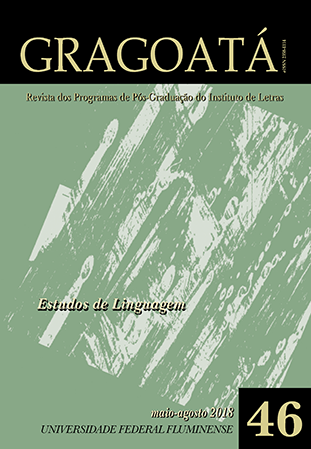A Estrutura Argumental Preferida de Cláusulas Hipotáticas Circunstanciais Temporais 'desgarradas' em 'memes quando'
DOI:
https://doi.org/10.22409/gragoata.v23i46.33588Palavras-chave:
Cláusulas Hipotáticas Circunstanciais Temporais. Cláusulas desgarradas. Memes quando. Estrutura Argumental Preferida (EAP).Resumo
Objetivamos analisar a Estrutura Argumental Preferida - EAP (DU BOIS, 1987) de Cláusulas Hipotáticas Circunstanciais Temporais desgarradas em memes quando, coletadas no site de pesquisa Google e na rede social Instagram. Adotamos os seguintes procedimentos metodológicos: coletamos 100 orações, dividimos de acordo com o tipo de verbo (verbos de dois argumentos (V2), verbos existenciais de um argumento (V1e) e verbos não existenciais de um argumento (V1~e)) e codificamos conforme as variáveis tempo e modo verbais; ordem dos constituintes; tipo semântico e sintático do verbo; manifestação, posição e estatuto informacional do sujeito de verbos transitivos e intransitivos e do objeto de verbos transitivos. Os resultados apontaram para os seguintes traços gerais: ordenação SV(O) e presença de verbos de estado ou ação (com tendência mais forte para o último tipo) no Presente do Indicativo. Em relação às tipologias verbais, foram detectados os seguintes traços, que confirmam parcialmente a EAP: Sujeito de V2 = [pronominal, pré, dado]; Objeto de V2 = [lexical, pós, novo]; Sujeito de V1e = [lexical/pronominal, pré, dado/novo]; Sujeito de V1~e = [lexical/pronominal, pré, novo]. Verificamos que essas construções constituem um tipo especial no que se refere à manifestação do sujeito. Logo, entendemos que, nessas construções, verbos V2 tendem a apresentar participantes da interação, pronominalizados e dados; já V1e e V1~e tendem a focalizar participantes da interação ou externos a ela (pronominais ou lexicais, dados ou novos), ainda que V1~e tenha maior tendência em apresentar sujeitos novos. Além disso, constatamos a frequência das cláusulas desgarradas em memes.
---
DOI: http://dx.doi.org/10.22409/gragoata.2018n46a1124
Downloads
Downloads
Publicado
Edição
Seção
Licença
AUTORIZAÇÃO
Autores que publicam em Gragoatá concordam com os seguintes termos:
Os autores mantêm os direitos e cedem à revista o direito à primeira publicação, simultaneamente submetido a uma licença Creative Commons Atribuição 4.0 Internacional (CC BY 4.0), que permite o compartilhamento por terceiros com a devida menção ao autor e à primeira publicação pela Gragoatá.
Os autores podem entrar em acordos contratuais adicionais e separados para a distribuição não exclusiva da versão publicada da obra (por exemplo, postá-la em um repositório institucional ou publicá-la em um livro), com o reconhecimento de sua publicação inicial na Gragoatá.
A Gragoatá utiliza uma Licença Creative Commons - Atribuição CC BY 4.0 Internacional.











